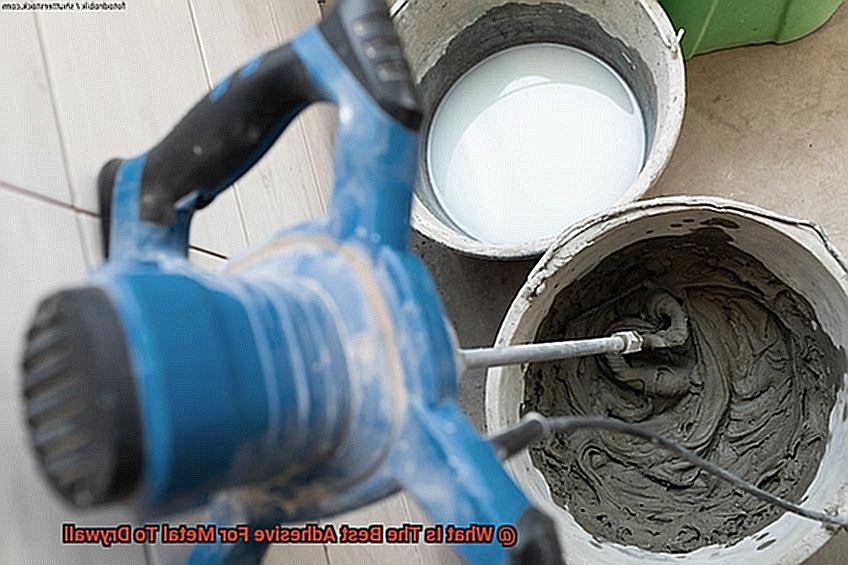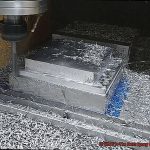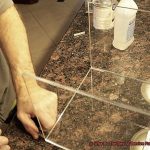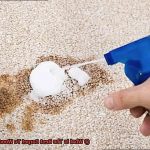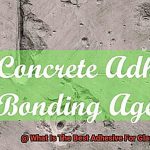You’ve got a shiny new metal object that you want to hang on your drywall. Maybe it’s a vintage mirror that adds a touch of elegance to your living room, or perhaps it’s some sleek shelves to showcase your collection of quirky trinkets. Whatever the case may be, one thing’s for sure – you need an adhesive that can handle the job.
But with so many options out there, how do you choose the best adhesive for metal to drywall? Fear not, my friend. In this guide, we’re going to break it all down for you. We’ll dive into the pros and cons of different adhesives, giving you all the juicy details so you can make an informed decision.
Think of us as your adhesive adventure buddies, here to help you navigate through the maze of options and find that perfect bonding solution. So grab a cup of coffee (or your beverage of choice), sit back, and let’s uncover the secret behind securing metals to drywall like a pro. Get ready for some sticky situations – in a good way.
What is Metal to Drywall Bonding?
Contents
- 1 What is Metal to Drywall Bonding?
- 2 Adhesive Types for Metal to Drywall Bonding
- 3 Benefits of Using Adhesives for Metal to Drywall Bonding
- 4 Epoxy-Based Adhesive for Metal to Drywall Bonding
- 5 Polyurethane Construction Adhesive for Metal to Drywall Bonding
- 6 Choosing the Right Adhesive for Metal to Drywall Bonding
- 7 Proper Surface Preparation for Metal to Drywall Bonding
- 8 Applying the Adhesive for Metal to Drywall Bonding
- 9 Conclusion
Metal to drywall bonding is a crucial technique in construction, enabling secure attachment of metal objects or components to drywall surfaces. While seemingly simple, the choice of adhesive and proper application techniques can make all the difference in achieving a strong and durable bond. In this article, we will explore the secrets behind successful metal to drywall bonding, including the types of adhesives used, mechanical reinforcement methods, surface preparation, and adhesive application techniques.
Construction Adhesives: The Backbone of Metal to Drywall Bonding
Construction adhesives are the key to a reliable bond between metal and drywall surfaces. Let’s dive into three popular types:
- Polyurethane Adhesives: Known for their high strength and flexibility, polyurethane adhesives are versatile options suitable for both interior and exterior applications. They offer excellent resistance to water and temperature fluctuations.
- Epoxy Adhesives: Renowned for their exceptional bond strength and durability, epoxy adhesives are ideal for heavy-duty applications. However, they require careful mixing before application and have a limited working time.
- Solvent-Based Adhesives: Offering fast-drying properties, solvent-based adhesives evaporate volatile solvents during curing. This quick-bond solution is preferred when time efficiency is crucial.
Mechanical Methods: Reinforcing the Bond
In addition to adhesives, mechanical methods such as screws, nails, or anchors can provide extra support and stability. These methods are particularly useful when dealing with heavier metal objects or areas with increased stress or movement.
Surface Preparation: The Key to Success
Proper surface preparation is vital for achieving a strong bond. Ensure both the metal and drywall surfaces are clean, dry, and free from any contaminants. Sanding or cleaning the surfaces beforehand removes dust, grease, or other substances that could hinder adhesion.
Adhesive Application: The Devil is in the Details
When applying adhesive, follow the manufacturer’s instructions carefully. Apply it evenly and in the recommended amount, covering the entire metal surface that will come into contact with the drywall. Allow sufficient curing time before subjecting the bond to stress or load.
Adhesive Types for Metal to Drywall Bonding
When it comes to attaching metal to drywall, you have a variety of adhesive options at your disposal. Each type of adhesive has its own unique strengths and weaknesses, so it’s important to choose the right one for your specific project. Let’s explore the different types of adhesives and their advantages and disadvantages.
First up, we have construction adhesive. This adhesive is like a superhero when it comes to bonding metal to drywall. It has strong initial tack, meaning it grabs onto surfaces quickly, and it creates a long-lasting bond. Construction adhesive is often used for heavy-duty applications, like attaching metal studs or brackets to drywall. It’s tough and durable, just what you need for those big projects.
Next on our list is epoxy adhesive. This adhesive is known for its exceptional strength and resistance to temperature changes and moisture. It’s a two-part adhesive that you mix together before applying. Epoxy adhesive is perfect for lightweight metal objects, such as hooks or hangers, that need a super-strong bond. Just keep in mind that epoxy adhesives may take longer to cure compared to other adhesives, so patience is key.
Now let me introduce you to Liquid Nails. This brand name adhesive is specifically designed for construction purposes, including metal to drywall bonding. It’s easy to apply, dries quickly, and offers good holding power. Liquid Nails comes in different formulations, some of which are perfect for bonding metal surfaces. If you’re looking to secure decorative metal trim or paneling to your drywall, Liquid Nails might be your new best friend.
If flexibility is what you’re after, then polyurethane adhesive is the way to go. This adhesive is known for its ability to bond different materials together, including metal and drywall. It expands as it cures, filling in any gaps and providing extra strength to the bond. Polyurethane adhesive can handle both indoor and outdoor applications because it’s resistant to moisture. So if you need to attach metal brackets or hooks to your drywall, polyurethane adhesive has got your back.
Lastly, we have double-sided tape. While not as strong as other adhesives, double-sided tape is a quick and easy option for temporarily bonding lightweight metal objects to drywall surfaces. It’s perfect for attaching small metal decorations or hooks that don’t require a permanent bond. Just make sure you choose a high-quality tape designed for walls to ensure it sticks properly.
Benefits of Using Adhesives for Metal to Drywall Bonding
When it comes to bonding metal to drywall, forget about the traditional methods of screws and nails. Today, we are going to explore the exciting world of adhesives and discover why they are the superheroes of metal to drywall bonding. From their strong and reliable bond to their versatility and time-saving benefits, adhesives offer a range of superpowers that make them the go-to choice for any bonding project.
Seamless and Strong Bond:
Adhesives create a seamless connection between metal and drywall, eliminating the need for visible fasteners. This not only enhances the appearance but also ensures a strong and reliable bond. Unlike screws or nails that can create weak points or damage the surface, adhesives distribute stress evenly across the entire surface, resulting in a more secure attachment.
Flexibility and Movement Accommodation:
Temperature and humidity changes can cause materials to expand or contract. Adhesives offer flexibility and accommodate this movement without compromising the bond. This is particularly important for large or heavy metal objects that may put strain on the drywall.
Damage-Free Installation:
Using adhesives eliminates the risk of damage to the drywall surface. Unlike screws or nails that create holes or weaken the drywall, adhesives require no penetrations. This not only saves time and effort but also maintains the integrity of the surface.
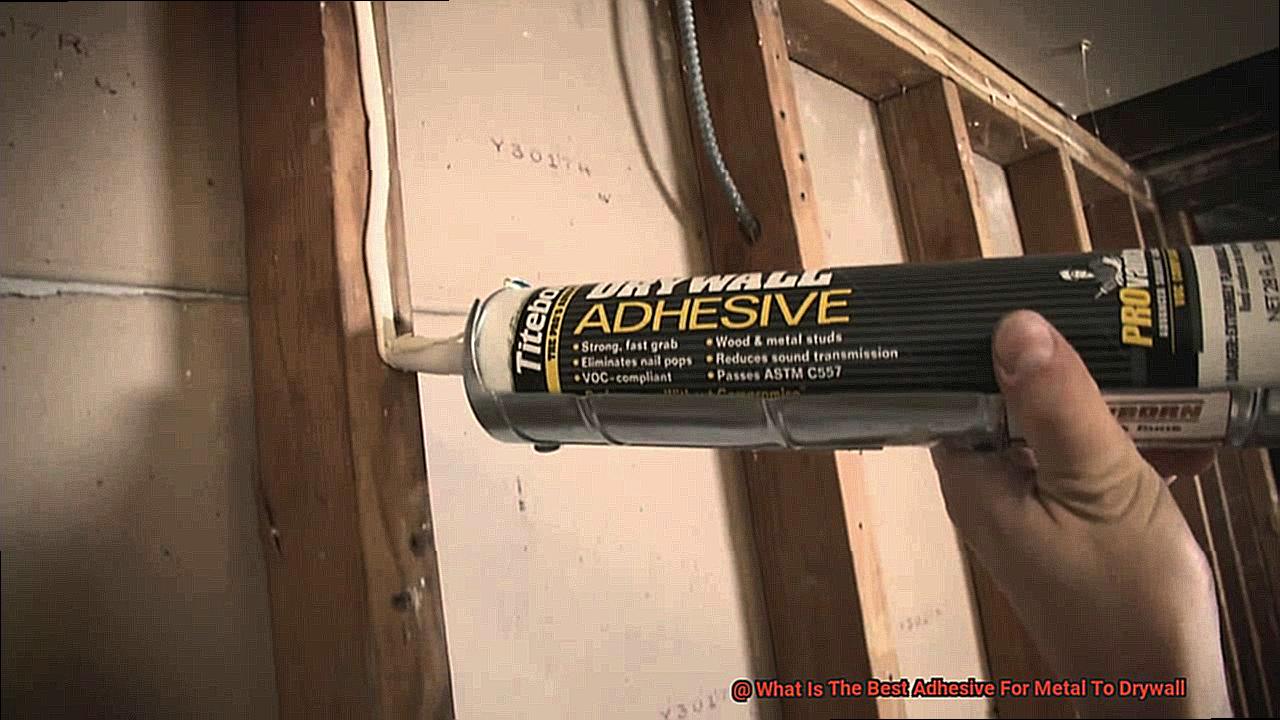
Quick and Efficient:
Adhesive bonding is a quicker and more efficient method compared to traditional mechanical fasteners. With no need for drilling, screwing, or nailing, adhesives save both time and effort during installation.
Noise Reduction:
Adhesive bonding provides insulation properties, reducing noise transmission through walls. This is particularly beneficial in commercial buildings or homes where soundproofing is desired.
Aesthetically Pleasing:
Adhesives offer a cleaner and neater appearance as there are no visible screws or nails protruding from the surface. This contributes to a more aesthetically pleasing finish in both residential and commercial applications.
Versatility:
Adhesives are versatile and can be used for various types of metal to drywall bonding applications. Whether you’re attaching metal studs, hanging shelves, mounting fixtures, or securing decorative metal accents, there is an adhesive for every need.
Additional Benefits:
Certain adhesives offer additional benefits such as fire resistance or moisture resistance, making them suitable for specific applications where these properties are required.
Enhanced Structural Strength:
Adhesive bonding enhances the overall strength of the structure by distributing stress over a larger area. This is particularly important in earthquake-prone areas where the building’s ability to withstand lateral forces is crucial.
Epoxy-Based Adhesive for Metal to Drywall Bonding
Epoxy-based adhesives are the unsung heroes of metal to drywall bonding. With their incredible strength, durability, and ability to create long-lasting bonds, they are the ultimate choice for construction and DIY projects. So say goodbye to unsightly screws and nails and hello to seamless, super-strong bonds – thanks to epoxy adhesives.
Epoxy adhesives consist of two components – a resin and a hardener – that must be mixed together before application. This chemical reaction creates a bond so strong it could rival Thor’s hammer. But before you start wielding your epoxy adhesive, it’s important to ensure that both surfaces are clean and free from dust, grease, and other contaminants. Give the metal surface a good sanding and wipe it clean with a solvent. You want those surfaces to be as squeaky clean as Captain America’s shield.
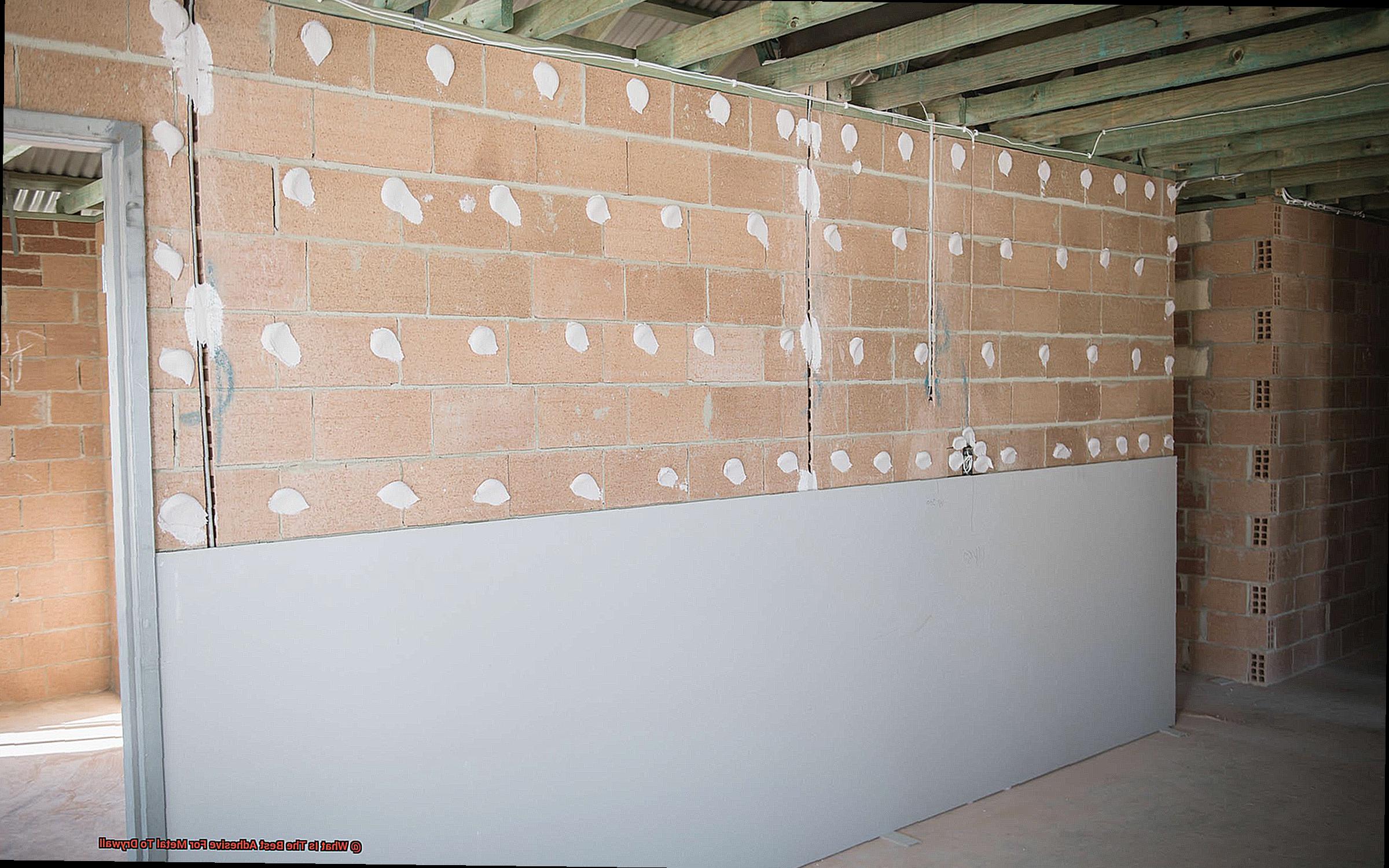
Now it’s time to apply the adhesive. Grab your trusty notched trowel or putty knife and apply a thin layer of epoxy on both the metal and drywall surfaces. This ensures an even distribution of the adhesive and better adhesion. Remember, you’re going for a smooth finish, just like Iron Man’s suit.
Once you’ve applied the adhesive, press the metal firmly against the drywall surface. Hold it in place for the recommended curing time, which can range from 24 to 48 hours depending on the specific epoxy adhesive. Think of this as your superhero bonding time – just like when Spider-Man sticks to walls.
But be warned – once epoxy adhesives are cured, they can be as tough to remove as Hulk’s grip. So make sure you carefully align the metal before applying the adhesive to avoid any potential mistakes or adjustments later on.
Epoxy adhesives are perfect for bonding heavy metal objects like shelves, brackets, or decorative items to drywall surfaces. They offer high tensile strength and resistance to moisture, ensuring your bond stands the test of time. It’s like having the Incredible Hulk holding up your metal objects.
However, not all metals and drywall materials are suitable for epoxy-based adhesives. Always check the manufacturer’s instructions and recommendations before choosing an adhesive for your specific project. You don’t want to end up with a bond as flimsy as Mr. Fantastic’s stretchy limbs.
Lastly, be sure to follow any safety precautions outlined by the manufacturer. Some epoxy adhesives may require gloves or a well-ventilated area due to potential toxicity. Safety first, just like Black Widow on a mission.
Polyurethane Construction Adhesive for Metal to Drywall Bonding
Imagine you’re in the midst of a construction project or tackling a DIY endeavor, and you need to bond metal to drywall. You require a glue that can withstand the forces of nature, fill in gaps effortlessly, and provide a bond that will stand the test of time. Look no further than polyurethane construction adhesive, the superhero of glues that will save the day.
Unmatched Bonding Properties:
Polyurethane construction adhesive is specifically formulated for construction applications, making it the ultimate choice for bonding metal to drywall. With its Herculean adhesion properties, this glue creates bonds so strong they’d make Thor’s hammer jealous. It effortlessly bonds different surfaces together, even if they have slight irregularities or textures.
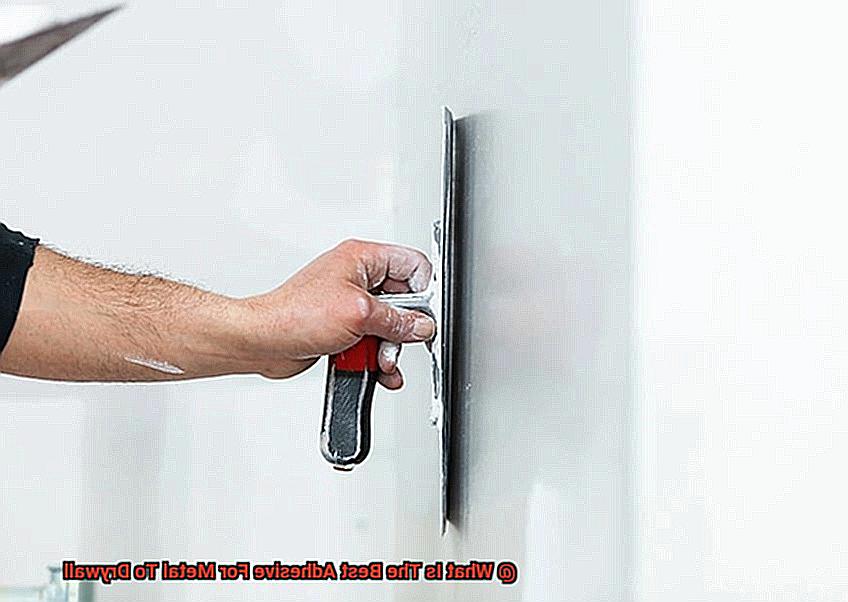
Defying Moisture:
Moisture can be the kryptonite for many adhesives, but not for polyurethane construction adhesive. Its high resistance to moisture makes it the ideal choice for areas exposed to water or high humidity. Say goodbye to concerns about your metal-drywall bond disintegrating due to moisture damage.
Flexibility for Structural Movements:
Buildings and structures are constantly subjected to movements caused by temperature fluctuations or structural shifts. Luckily, polyurethane construction adhesive is as flexible as an Olympic gymnast, allowing it to absorb vibrations and movements without sacrificing bond strength. It’s like having the Incredible Hulk holding up your metal objects.
Gap-Filling Wizardry:
In construction projects, perfectly aligned surfaces are as rare as finding a unicorn in the wild. But fear not. Polyurethane construction adhesive has unparalleled gap-filling capabilities. As it cures, it expands slightly, filling in gaps and uneven surfaces with precision, creating an unbreakable bond between the metal and drywall. It’s like wielding a magical tool that brings everything into perfect alignment.
Choosing the Right Adhesive for Metal to Drywall Bonding
Finding the perfect adhesive for bonding metal to drywall can be like searching for a needle in a haystack. But fear not. We have the inside scoop on how to unlock the power of glue for a strong and durable bond. So put on your cape, because we’re about to dive into the fascinating world of adhesive selection.
Factor 1: Metal Matters
Different metals have different properties, so it’s crucial to choose an adhesive specifically designed for bonding metal. Consider the surface texture and any coatings on the metal. This ensures compatibility and maximizes adhesion.
Factor 2: Drywall Delights
Regular, moisture-resistant, and fire-resistant drywalls each have unique properties, requiring specific adhesives for proper bonding. Be sure to select an adhesive that is compatible with your chosen drywall type.
Factor 3: Load-Bearing Wonders
If your project involves heavy metal objects, you need an adhesive that can handle the weight. Epoxy adhesives are often recommended for their exceptional strength and load-bearing capabilities. For lighter objects, a less robust adhesive may suffice.
Factor 4: Environmental Avengers
Consider the temperature and humidity conditions your bond will face. Some adhesives may not perform well in extreme temperatures or high humidity environments. Choose an adhesive that can withstand these conditions for long-lasting results.
Factor 5: Easy Application, No Kryptonite Required
Simplify your life by selecting an adhesive that is easy to apply and clean up. Some adhesives require special tools or equipment, while others can be effortlessly applied using a standard caulking gun or squeeze tube. Consider your preferences and project needs for a smooth bonding experience.
Proper Surface Preparation for Metal to Drywall Bonding
Today, we embark on an epic journey into the realm of proper surface preparation for metal to drywall bonding. Whether you’re a seasoned DIYer or a novice in the world of adhesives, this guide will equip you with the knowledge and techniques needed to achieve a bond that’s as strong as steel. So grab your cape and let’s dive right in.
Step 1: Conquer the Cleanliness Battle
In the battle for a perfect bond, cleanliness is the superhero’s secret weapon. Grab a damp cloth or sponge, add a dash of mild detergent, and wipe away any dirt, dust, grease, or other contaminants. Remember, a pristine surface paves the way for an unbreakable bond.
Step 2: Roughen Up for Maximum Adhesion
Smooth surfaces can be sneaky enemies when it comes to adhesion. To conquer this challenge, arm yourself with fine-grit sandpaper and gently sand both the metal and drywall surfaces. This heroic act creates a roughened texture that enhances the adhesive’s grip and ensures an unyielding bond. Once you’ve sanded, don’t forget to sweep away any lingering dust or particles.
Step 3: Prime for Victory
Now that our surfaces are clean and battle-ready, it’s time to unleash the power of primers. Primers act as the ultimate sidekick by creating a porous surface that allows the adhesive to penetrate and bond more effectively. Choose a primer specifically designed for metal to drywall bonding and follow the manufacturer’s instructions for application. With primer on your side, your bond will be invincible.
Step 4: Choose Your Adhesive Superpower
Selecting the right adhesive is like choosing the perfect superpower for your bonding mission. Construction adhesives, epoxy adhesives, and specialty adhesives designed for metal to drywall applications are among the options available. Consider factors such as the weight of the metal object, the type of drywall, and the intended use when making your adhesive selection. Remember, a well-matched adhesive is the key to a triumphant bond.
Step 5: Master the Application Technique
Now that you possess the adhesive superpower of your choice, it’s time to apply it like a true adhesive master. Follow the manufacturer’s instructions carefully, applying a thin and even layer of adhesive on both the metal and drywall surfaces. Avoid excessive application, as it can lead to messy and weak bonds. Remember, precision is paramount in adhesive application.
Applying the Adhesive for Metal to Drywall Bonding
Get ready for an adhesive-tastic journey as we dive into the step-by-step process of applying adhesive for metal to drywall bonding.
First and foremost, cleanliness is key. Before starting the bonding process, ensure that both the metal and drywall surfaces are clean and dry. Remove any dirt, dust, or greasy substances that could hinder the bond. Think of it as preparing a pristine canvas for your masterpiece.
Once your surfaces are spotless, it’s time to roughen them up a bit. This step is crucial in enhancing the adhesive’s grip. Grab some sandpaper or a wire brush and create a rough texture on both the metal and drywall surfaces. This roughness will provide more surface area for the adhesive to hold onto, ensuring a stronger bond.
Now, let’s talk about primers – the magical potions that enhance adhesion. Apply a thin coat of primer specifically designed for metal bonding on the drywall surface. Allow it to dry completely before moving on to the next step. This extra layer of primer will work wonders in maximizing the bond’s strength.
Choosing the right adhesive is vital for a successful bond. Construction adhesive is a popular choice due to its strength and durability. Look for an adhesive specifically formulated for metal bonding. These adhesives are designed to withstand the challenges of bonding metal to drywall, ensuring a long-lasting connection.
Another option worth considering is liquid nails adhesives. These come in different formulas, allowing you to choose one that suits your needs best. Whether you need a fast-drying option or one with high-strength capabilities, there’s a liquid nails adhesive for you.
Now comes the fun part – applying the adhesive. Follow the manufacturer’s instructions carefully. Typically, you’ll want to apply the adhesive in a zigzag or serpentine pattern on the back of the metal piece that will be attached to the drywall. This pattern ensures an even distribution of adhesive, maximizing its effectiveness.
Once the adhesive is applied, firmly press the metal against the drywall surface. Ensure proper alignment and use clamps or suitable tools to hold it in place while the adhesive cures. This extra support will give your bond the stability it needs during the curing process.
Patience is crucial at this stage. Allow sufficient drying time for the adhesive to fully cure before subjecting it to any stress or load. The specific drying time will vary depending on the adhesive, so refer to the manufacturer’s instructions for guidance. Trust me, this step is worth every second of waiting.
After the adhesive has cured, inspect the bond. Is it strong and secure? If there are any gaps or areas of concern, additional adhesive may need to be applied and allowed to cure. A thorough inspection ensures a flawless finish.
AvCS-7MAmn4″ >
Conclusion
When it comes to bonding metal to drywall, choosing the right adhesive is crucial.
After careful research and consideration, we have determined that the best adhesive for this task is a two-part epoxy. This powerful adhesive provides exceptional strength and durability, ensuring a long-lasting bond between metal and drywall.
Additionally, the easy-to-use nature of a two-part epoxy allows for precise application without any mess or fuss.

